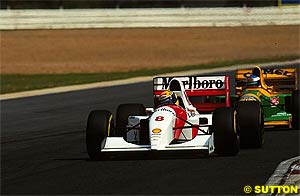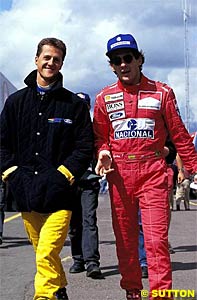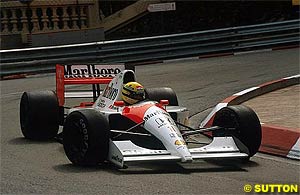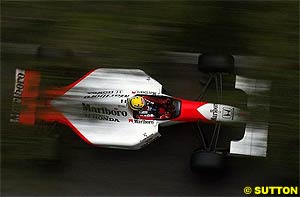
Atlas F1 Senior Writer
Thomas O'Keefe looks at what made Ayrton Senna a great driver and how he fits in between Juan Manuel Fangio and Michael Schumacher on the lineage of F1's legends
In Senna's case, there are parallels in the erosion of his legend. When Tina Turner sang "Simply The Best" at Adelaide after the 1993 Australian Grand Prix, Senna's last win, no one had to be told who she was singing about. But as Michael Schumacher's star has risen over these last 10 years and his record-breaking statistics have piled up, shattering all but Senna's record of 65 pole positions, assessing Senna's legacy is becoming a more serious parlor game. Was Senna ever and is he still the best in his era of Formula One, and if so, why?
Senna's place in the Pantheon of Great Drivers seemed secure when he died but Michael Schumacher has by now surely demonstrated that he is more than a flash in the pan or a guy lucky enough to always be in the fastest car. Even for the most grudging of Schumacher bashers, it would be hard not to admire what Michael Schumacher has done at Ferrari, taking the whole team up by the scruff of the neck and bringing it from failure to phenomenal success in record time. But having watched Senna and Schumacher both at close range, I see a real congruence in the bag of tricks that both Senna and Schumacher had and brought to Formula One, making it hard to choose between them. Indeed, some of what we think of now as vintage Schumacher, was possibly passed down from Senna to Schumacher, as Senna's most willing and able student.
In the course of the recent airing by Speed Channel in the United States of the "F1 Decade" replays of the 1993 and 1994 Formula One seasons, we have had a rare and timely look at the two drivers in a crossover era, when Schumacher was growing stronger in terms of the equipment he had under him at a time when Senna was going in the opposite direction. The 1993 McLaren MP4/8-Ford V8 spec engine in Senna's car was not the factory Ford V8 unit Schumacher had in his 1993 Benetton B193-Ford and the 1994 Williams-Renault team Senna joined the next year turned out not to be as good as the 1994 Benetton B194-Ford Schumacher was running that day when it all came to an end for Senna at Imola. It is sometimes overlooked that this titanic twosome had barely 40 races together and during that time Senna had 10 wins and Schumacher had a creditable five wins.
Schumacher's admiration for his older colleague came through in the deference he showed Senna. As Schumacher said in the post-race press conference at the 1993 Canadian Grand Prix, when he finished on the podium in third, after inheriting that position when a misfire led to Senna's retirement late in the race: "I always enjoy fighting, especially with Senna. He is a good driver and a hard driver. If you can fight with somebody like him that's a good sign."
By Imola 1994, Schumacher's education was nearly complete as the 1994 Brazilian Grand Prix showed, where it appeared that the student rattled the teacher. Although Senna had qualified the Williams-Renault on pole (as indeed he would for all three 1994 races before his death, in each case with Schumacher right next to him on the front row), in the latter stages of the race at Interlagos, while chasing Schumacher, Senna spun out at the Subida Dos Boxes corner, making the kind of uncharacteristic error that he had not made since 1988 when he hit the Armco barrier at the Portier turn at Monaco when he lost concentration while leading the race. In retrospect, it surely appears from the first three races in 1994 that Michael Schumacher would have had the upper hand in the 1994 season even had Senna lived.
But putting aside for the moment the fascinating but ultimately unresolvable Senna vs. Schumacher comparison, it is beyond dispute that Senna's sheer genius behind the wheel put a smile on everyone's face, people feeling tickled pink as they recognized that they were privileged to be in the presence of a master.
Senna put in an absolutely blistering and breathtaking qualifying lap in the McLaren-Honda with the 3.5 litre V12, around the streets he called home for much of his racing career. The lap begins as Senna comes up the hill to Massanet and approaches Casino Square at full tilt, correcting the McLaren as it bottoms out on the bump in the road just past the Monte Carlo Casino. In the run downhill to Mirabeau, the little shops and bars on the left wiz by as Senna's famous yellow helmet leans into the righthander and the McLaren just touches the kerb as he turns in at Mirabeau, rounding the corner and setting up for the then-Loews hairpin, which he maneuvers around with great busyness, downshifting and blipping the throttle as he makes the turn, simultaneously grabbing the gearshift while overcorrecting the steering wheel to compensate for the wheelspin as he gets back on the throttle to head for Portier Inferieur, the waterfront and the tunnel.
Senna has the Honda V12 screaming bloody murder as he exits the tunnel and heads for the chicane, downshifting manually so quickly that the high-pitched whine of the engine makes it sound like it is in pain as it is on the limit of the rpms available.
But the pain is not over yet, as Senna heads toward the blind corners of the swimming pool complex which even Senna described as dangerous, saying "it is very difficult to commit yourself to drive quick[ly] through there." When a slower backmarker suddenly appears 85% of the way through his lap and toward the end of the swimming pool turns, Senna does not lift, somehow manages to get by without ruining his lap, does another series of screaming downshifts as he turns in to Rascasse, all the while blipping the throttle and using his finesse with the steering wheel, finally putting both hands on the wheel as he accelerates onto the main straight and passes Ron Dennis who is smiling broadly under his trademark earphones, his whole upper body chuckling at the spine-tingling performance he has just observed, Senna's 56th pole position of the 65 he would achieve.
The second commanding Senna performance was in Nigel Mansell's Championship year, the 1992 Monaco Grand Prix, when Mansell's Williams FW14B, powered by Renault, was clearly superior to the McLaren-Honda, now in its last season in Formula One. But no one told Senna he could no longer win with the aging Honda powerplant and Mansell suffered one of his more maddening defeats that day in Monte Carlo.
Apart from the driving prowess Senna demonstrated in qualifying and during the races, there is one other episode from a practice session in Spa, just six races before Senna was killed, that inadvertently sheds light on Senna's incredible eyesight, skill and quick reflexes. During Friday practice for the 1993 Belgian Grand Prix, Alex Zanardi in the Lotus 107 had a severe crash just over the brow at Eau Rouge when the active suspension of the Lotus failed at the worst possible moment, which led to Zanardi's Lotus hitting the barriers on the inside of Eau rouge, jettisoning its wheels and then spinning the tub of his Lotus like a top across to the gravel trap on the other side of the track, leaving a major debris trail behind him of tires and chassis parts.
The next two cars on the track making their way up the hill from La Source to Eau Rouge were the McLarens of rookie Michael Andretti, followed shortly by his teammate Ayrton Senna. Although the corner marshals on the crest of Eau Rouge had begun to wave their yellow flags, when Andretti had climbed the hill and arrived on the scene, errant wheels from the Lotus were still rolling around and Andretti slowed to pick his way through the debris.
Just then, Senna appeared, still at speed over the brow of Eau Rouge and in a flash realized that he had to force himself into a spin or he would hit either Michael, the corner marshals or Zanardi in his Lotus, now having come to a halt, lodged up against the Armco barrier on the far side of the Eau Rouge gravel trap. With incredibly quick judgment and adroit handling of the car, Senna analyzed the accident scene in an instant and somehow managed to spin his McLaren through the middle of the debris field, just missing Michael Andretti's McLaren by inches as well as everyone else and ending up gently hitting the inner Armco at Eau Rouge, backing it in about five feet away from Zanardi's Lotus. Miraculous? Yes, for everyone else, but all in a moment's work for Senna.
Was he the greatest driver of all time? Of his time? Better than Schumacher, Fangio and Clark? It hardly matters. The best testament to the loss we feel on this 10th Anniversary of his death is the continued reverence to his memory felt by so many who witnessed his performance during his prime and were awed by what they saw. Although Clark never knew Senna, it is clear from the last time Fangio and Senna publicly met – during the podium ceremonies at Interlagos for the 1993 Brazilian Grand Prix – that each of the South American superstars admired the other, Senna coming down from the elevated podium to the stage during the trophy presentation for a bear hug with the legend from Balcarce, Argentina.
Michael Schumacher was also on the podium that day with Senna in Brazil in 1993, having finished in third place, a callow youth by comparison to the mature and sophisticated Schumacher we know now, looking on as a bystander at the embrace of Fangio and Senna. He could not know then how much these two men would come to mean to him someday.
But seven years on, at Monza for the 2000 Italian Grand Prix, Michael Schumacher showed that he understood the significance of the linkage between Senna and himself when, upon Schumacher scoring his 41st victory, equaling one of Ayrton Senna's records, an extraordinary thing happened: the supposedly unemotional German literally broke down in tears at the post-race press conference at the very mention by a reporter of the name "Senna". Michael's brother, Ralf, was sitting to his left and looked stunned as his older brother buried his face in his hands and was rendered speechless. Mika Hakkinen, the supposed Finnish Iceman, no stranger to tears at Monza himself, was on Michael's right and instinctively knew what to do: he reached out and put his arm around Schumacher and moved the questioner on to other topics.
In that one moment of unrehearsed emotion, we all knew that Schumacher knew too: such was Senna that he could bring smiles and tears to all of us. Requiescat in Pace.
Ayrton Senna's death is Formula One's equivalent to the death of JFK in the political context: two charismatic but flawed heroes cut down in their prime, forever young in our mind's eye, their deaths forever surrounded by controversy, intrigue and official investigations, from the grassy knoll of Dallas to Tamburello curve at Imola where Senna went off and never came back.
 While Kennedy's stewardship in his brief 1000 days as President of Camelot was rather quickly brought into perspective once the historians and muckrakers took over from earlier biographies written by Kennedy's staffers, even the revisionist historians have not entirely undermined the core appeal of JFK as a man somehow apart from the rest of us in the way he went about handling the crises he faced and manipulating the emerging power of television without which he would probably never have been elected President.
While Kennedy's stewardship in his brief 1000 days as President of Camelot was rather quickly brought into perspective once the historians and muckrakers took over from earlier biographies written by Kennedy's staffers, even the revisionist historians have not entirely undermined the core appeal of JFK as a man somehow apart from the rest of us in the way he went about handling the crises he faced and manipulating the emerging power of television without which he would probably never have been elected President.
 In the 1993 season, both drivers had their moments of brilliance and although Schumacher did win one race that season, the 1993 Portuguese Grand Prix at Estoril, Schumacher spent many laps in school watching Senna while chasing him around Grand Prix circuits like Spain, Brazil and Canada. Throughout the 1993 season, the Williams FW15C-Renault cars of Alain Prost and rookie Damon Hill were the class of the field and the Ford-powered entries of Senna and Schumacher were plainly at the head of the second division, the two often qualifying next to one another and racing together all season, and a particularly wet season it was. Remember Donington 1993? Having been in only 23 Grands Prix prior to the 1993 season and having only one win, Schumacher was in effect a graduate student in Senna's University of Formula One. Schumacher shadowed Senna all season long, learning from him both on the track and off, including the post-race press conferences where Senna's polished and often insightful remarks were a contrast to Schumacher's bare bones comments in then-halting English.
In the 1993 season, both drivers had their moments of brilliance and although Schumacher did win one race that season, the 1993 Portuguese Grand Prix at Estoril, Schumacher spent many laps in school watching Senna while chasing him around Grand Prix circuits like Spain, Brazil and Canada. Throughout the 1993 season, the Williams FW15C-Renault cars of Alain Prost and rookie Damon Hill were the class of the field and the Ford-powered entries of Senna and Schumacher were plainly at the head of the second division, the two often qualifying next to one another and racing together all season, and a particularly wet season it was. Remember Donington 1993? Having been in only 23 Grands Prix prior to the 1993 season and having only one win, Schumacher was in effect a graduate student in Senna's University of Formula One. Schumacher shadowed Senna all season long, learning from him both on the track and off, including the post-race press conferences where Senna's polished and often insightful remarks were a contrast to Schumacher's bare bones comments in then-halting English.
 Take, for example, Senna's qualifying lap for the 1991 Monaco Grand Prix. A gripping and committed qualifier, these are Senna's own introspective words describing what it was like for him to qualify at Monaco in the McLaren Honda:
Take, for example, Senna's qualifying lap for the 1991 Monaco Grand Prix. A gripping and committed qualifier, these are Senna's own introspective words describing what it was like for him to qualify at Monaco in the McLaren Honda:
"Qualifying is a real sprint. More than at any other circuit, it is a tremendous sprint. And sometimes it takes so much energy, so much concentration that you really see nothing else other than the narrow road, the Armcos, the walls and your wheels. Because you are positioning your wheels with the Armco all the time and you are cutting it as close as that, going at a 100, 200, 250 kilometers an hour, so it's a tremendous excitement to drive around Monte Carlo."
 Senna had been circulating behind Mansell in second place, but then Senna seized on a late pitstop for tires by Mansell with just a few laps to go to pass Mansell on the track while Mansell's Williams was in the pits for a longish pit stop. For the closing six laps of the race, the Englishman, who had won all five 1992 Grands Prix to that point in the season, dogged the Brazilian's McLaren-Honda around Monte Carlo in his superior Williams-Renault, trying everything he could think of to get around Senna – at the hairpin, in the tunnel, at the chicane, at the swimming pool complex, and finally at Rascasse where Mansell's right front wheel practically touched Senna's left rear, but to no avail, as Mansell finished 0.215 of a second behind Senna. Another smile no doubt from Ron Dennis as Senna took his cool-down lap, driving with one hand and clutching his dearly loved green and yellow Brazilian flag, picked up from a bystander, which he waved from the cockpit. Winning with style and a smile.
Senna had been circulating behind Mansell in second place, but then Senna seized on a late pitstop for tires by Mansell with just a few laps to go to pass Mansell on the track while Mansell's Williams was in the pits for a longish pit stop. For the closing six laps of the race, the Englishman, who had won all five 1992 Grands Prix to that point in the season, dogged the Brazilian's McLaren-Honda around Monte Carlo in his superior Williams-Renault, trying everything he could think of to get around Senna – at the hairpin, in the tunnel, at the chicane, at the swimming pool complex, and finally at Rascasse where Mansell's right front wheel practically touched Senna's left rear, but to no avail, as Mansell finished 0.215 of a second behind Senna. Another smile no doubt from Ron Dennis as Senna took his cool-down lap, driving with one hand and clutching his dearly loved green and yellow Brazilian flag, picked up from a bystander, which he waved from the cockpit. Winning with style and a smile.
 It is worth noting that there are similar stories as to Bernd Rosemeyer and Jim Clark threading the needle with the Auto Union and Lotus, respectively, in similar unexpected circumstances that called upon their lightening quick reflexes. Ironically, all three of these superlative drivers – Rosemeyer, Clark and Senna, would die at the wheel under conditions that strongly suggested that it was not the driver but the car that killed them.
It is worth noting that there are similar stories as to Bernd Rosemeyer and Jim Clark threading the needle with the Auto Union and Lotus, respectively, in similar unexpected circumstances that called upon their lightening quick reflexes. Ironically, all three of these superlative drivers – Rosemeyer, Clark and Senna, would die at the wheel under conditions that strongly suggested that it was not the driver but the car that killed them.
|
Contact the Author Contact the Editor |
Please Contact Us for permission to republish this or any other material from Atlas F1.
|
Volume 10, Issue 15
Special Issue
View from the Imola Paddock
The Feud with Prost
A Lesson in Safety
From Fangio to Schumacher
The Dark Side of the Man
Memories of May
Keith Sutton: The Senna Collection
Columns
Elsewhere in Racing
> Homepage |